ISSN ONLINE(2319-8753)PRINT(2347-6710)
ISSN ONLINE(2319-8753)PRINT(2347-6710)
P.Balashanmugam1, V.Nehrukumar2, K.Balasubramaniyan3,G.Balasubramanian1
|
| Related article at Pubmed, Scholar Google |
Visit for more related articles at International Journal of Innovative Research in Science, Engineering and Technology
The paper suggests that vulnerable institutions like schools and hospitals should be located about 50m away from the roadside unless any special arrangement to alleviate sound is used. Noise measurements were taken at seventeen chosen areas with high population density, heavy traffic, commercial and residential buildings. At each sampling site six readings were taken after an interval of every 45 minutes in June 2012. Average, maximum and minimum values were calculated and compared with standards prescribed by the Central Pollution Control Board. Noise pollution was measured and analyzed and it was noticed that the maximum average of noise level was measured. The major contribution of the traffic noise, towards overall noise pollution scenario, is a well-known established fact. Traffic noise from highways creates problems for surrounding areas, especially when there are high traffic volumes and high speeds. Vehicular traffic noise problem is contributed by various kinds of vehicles like heavy, medium trucks/buses, automobiles and two wheelers. Amongst, noise pollution is an important type, which causes more annoyance and health problems to the human beings. The present work discusses the fundamentals of acoustics and analysis of vehicular traffic noise. The vehicles represent the most important noise source. It was estimated to about 80% from road vehicles. Road traffic noise is one of the most widespread and growing environmental problems in urban areas. The impact of road traffic noise on the community depends on various factors such as road location and design, land use planning measures, building design, vehicle standards and driver behavior. In the study area 17 locations are identified to measure noise level. By using sound level meter noise levels are measured at different peak sessions i.e. morning, afternoon and evening.
Keywords |
| Noise Pollution, Sound Level meter, Traffic volume, vehicular traffic noise, prediction model |
INTRODUCTION |
| Traffic noise is probably the most rigorous and pervasive type of noise pollution. Traffic noise has become a serious problem nowadays because of inadequate urban planning of the city in the past. Homes, schools, offices, hospitals, commercial business centers, and other community buildings were routinely built close to the main roads of the municipality without buffer zones or adequate sound proofing. The problem has been compounded by increases in traffic volumes (two wheelers, heavy motor vehicles, and other vehicles) far beyond the expectations of our early urban planners. This alarming increase in the volume of traffic is actually inversely related to the degradation of the environment. Noise pollution is one of the major environmental pollutants that are encountered in daily life and has direct effects on human performance. Sound pressure is a basic measure of the vibrations of air that makes up sound, and because the range that the human listeners can detect is very wide, these levels are measured on the logarithmic scale with units of decibel (dB). |
| The word "noise" is derived from the Latin word "nausea" meaning seasickness. Noise can be defined as the level of sound that exceeds the acceptable level and creates an annoyance. Noise is any sound independent of loudness which can produce an undesired physiological or psychological effect on an individual group. Noise is a major source of friction between individuals. The major sources of noise are industrial noise, community noise and traffic noise. Out of three parameters, the source that affects the most is traffic or vehicular noise. In this traffic noise, almost two- third of the total noise pollution in an urban area is contributing by vehicle noise. Vehicle noise includes the following sources: |
| • Engines. |
| • Exhaust systems. |
| • Tires interacting with the road. |
| • Horns. |
| • Aerodynamic friction and by the interaction between vehicles. |
| • Sounds of cooling fans, gearboxes and brakes. |
| The increase in magnitude and severity of traffic noise depends on the following factors |
| • Population growth and urbanization associated with the growing number of automobiles. |
| • Vehicle type, its mode of operation and flow. |
| • Dimension, position and surface materials of the roads. |
| • City prior planning. |
| • City center crossroad signal system. |
| • Commercial and industrial activities in the residential areas, in addition to high traffic density. |
| • Disobeying traffic rules. |
| All the above-mentioned factors combined together lead to increased vehicular noise levels. Noise pollution does not get noticed and it is not like a kind of chemical reaction. It is only like a wave which widespread in the air and does not have any stable and normally observable effect like water or soil pollution. Noise pollution is regarded as a significant criterion in determining the quality of life in cities and affects the social welfare. |
| The noise originates from human activities, especially the urbanization and the development of transport and industry. Though, the urban population is much more affected by such pollution, however, small town/villages along side roads or industries are also victim of this problem. Noise is becoming an increasingly omnipresent, yet unnoticed form of pollution even in developed countries. According to Birgitta and Lindvall (1995), road traffic, jet planes, garbage trucks, construction equipment, manufacturing processes, and lawn mowers are some of the major sources of this unwanted sounds that are routinely broadcasted into the air. Though noise pollution is a slow and subtle killer, yet very little efforts have been made to ameliorate the same. It is, along with other types of pollution has become a hazard to quality of life. Kiernan (1997) finds that even relatively low levels of noise affects human health adversely. It may cause hypertension, disrupt sleep and/or hinder cognitive development in children. The effects of excessive noise could be so severe that either there is a permanent loss of memory or a psychiatric disorder (Bond, 1996). Thus, there are many an adverse effects of excessive noise or sudden exposure to noise. In India, the problem of noise pollution is wide spread. Several studies report that noise level in metropolitan cities exceeds specified 60dB. Murli and Murthy (1983) also found that traffic noise in Vishakhapatnam exceeds 90dB even in morning hours that acts as a source of nuisance. The noise pollution is not a unique problem for developing countries like India only. In China, till third century B.C., instead of hanging men for dangerous crimes, noise was used for their torturing. The worrisome effects of noise are dangerous enough that noise problem is considered next to crime by certain countries (Kapoor and Singh, 1995). Bond, (1996) reports that 16% of people in Europe are exposed to 40 dB or more of traffic noises in their bedrooms at night compare it with W.H.O.'s average estimates of 30 to 35 dB for undisrupted sleep. Several initiatives have been taken by various countries to check the noise level. Noise pollution is one of the consequences of our modern life. It doubles every year along with progress in society and industry and it has become the part of our daily life. Transportation and light industries are found to be the two major sources of noise pollution in India (Bose and Bhattacharya, 1973). Noise pollution and its effects in industrial environment have been studied by many people. Kameswaran (1982) carried out a detailed audiometric testing of workers working in textile industry, refinery, chemical factories, valve industry, foundry, electrical industry, oil mill and fertilizer manufacturing units. He found that foundry workers had the highest percentage of noise induced hearing loss (NIHL) while workers of electrical industry had lowest percentage of NIHL. The spectral analysis of noise produced in a power station. Rotating machinery was found to be the source for two constant frequency components of noise. Surenedran et al. (1999) reported on aerodynamic noise generated by control valves. They found that noise level increased with the increase in the pressure ratio. Naik (1999) reported noise levels in a pumping house were in the hazardous range of 92.4 and 97.3 dB (A). Major noise sources in industries are air compressor and pumps, diesel engine, electrical equipment, gas farbing, etc. The present study was undertaken to assess the extent of noise pollution in and around SIPCOT industrial complex near Perundurai, along the National Highway-47 (between Salem and Coimbatore). Noise levels were measured at selected industries and in residential areas near SIPCOT industrial complex. |
| A. Harmful effects of noise on human beings |
| Noise is considered a serious threat to the environmental health. Some of the adverse effects of noise pollution are given below: |
| • It interferes with speech. In the presence of noise we may not able to follow, what the other person is saying. |
| • Noise leads to emotional and behavioral stress. A person may feel disturbed in the presence of loud noise such as produced by heating of drums. |
| • Noise may permanently damage hearing. A sudden loud noise can cause severe damage to the eardrum. |
| • Noise increases the chances of occurrence of diseases such as headache, blood pressure, heart failure, etc. |
| • Noise leads to increased heart beat, constriction of blood vessels and dilation of pupil. |
| • Noise is a problem especially for patients who need rest. |
| • Noise may cause damage to liver, brain and heart. |
| B. Introduction to vehicular traffic noise |
| Traffic noise will continue to increase in magnitude and severity because of population growth, urbanization, and the associated growth in the use of automobiles. It will also continue to grow because of sustained growth in of vehicles. Highway noise is the sum of the total noise produced at the observer point by all the moving vehicles on the highway. Thus the fundamental component is the noise produced by the individual vehicles, which depend on the vehicle type and its mode of operation. The overall noise is also dependent on the characteristics of the vehicle flow and the relative proportions of the vehicle types included in the flow. Knowledge of these factors is thus necessary to define the characteristics of highway noise and to subsequently predict the associated noise level in the surrounding area. The amount of information required depends on the degree of accuracy desired in the predictions, which in turn is a function of the method selected to characterize the temporal variation of the noise. Thus the complexity of highway noise model will depend on the noise descriptor selected. |
| C. Vehicle noise sources |
| It is well-established fact that vehicular traffic noise is a major source of community annoyance especially near highway carrying fast traffic. Many people consider the truck noise to be the principal offender. Numerous components of noise sources contribute to the overall truck noise. These sources, however, can logically be grouped into the major categories as under. |
| 1. Power Plant and Transmission Noise Sources- engine, exhaust, intake, cooling system, drive train and so on, |
| 2. Running gear Noise Sources - tyre road interaction, differential, propeller shaft. Noise from the power-plant increases as engine speed increases. While noise from tyre increases as vehicle speed increases. Trucks tend to operate at nominally constant engine speed, so that engine and exhaust noise do not vary appreciably with vehicle speed. Therefore, at lower highway speeds the engine-exhaust noise is dominant, while at higher vehicle speeds tyre-pavement interaction becomes the dominant source of noise. The exact speed at which the tyre-roadway noise starts to dominate over the power-plant-associated noise is a highly complicated function of such variables as tyre characteristics, engineexhaust characteristics, road surface, and vehicle design and condition. As a tyre rolls over a road surface, it displaces macroscopic and microscopic volumes of air. The 'macroscopic' applies to volume displacements of the same order as the volume of the tyre itself, and 'microscopic' applies to much smaller volumes. These air displacements generated pressure disturbances in the surrounding air. Pressure disturbances in the audio frequency range and of sufficient amplitude are responsible for the production of noise along the roadway. |
| D. Effects of various factors on traffic noise |
| Rapidly changing population patterns on the national scene and developed public expectancy in terms of environmental effects have generated the requirement to furnish environmental impact statement is the noise that my result from the traffic noise is more complicated due to the facts that highways are not flat, straight or free from natural terrain variation. The factors like vehicle speed, density, traffic mix, width of median and number of lanes are not constant. Therefore, for traffic noise each of these parameters is taken into account. A number of factors can influence the traffic noise, whose major sources are noise emission from vehicle, interaction of tyres with road surface, traffic flow conditions and driving habits. In general, these factors can be grouped under four categories namely traffic factors, road factors, vehicle factors, |
SITE SELECTION |
| To measure the traffic noise pollution, the first task was site selection. So, due to surveys of different areas and nature of noise problem in Cuddalore town. This place is situated in South Arcot, Tamil Nadu, India, its geographical coordinates are 11° 45' 0" North, 79° 45' 0" East and its original name (with diacritics) is Cuddalore. Cuddalore Town is the Head Quarters of the Cuddalore Taluk and District. It is located at the estuary of river Gadilam and Pennaiyar with Bay of Bengal. The town is at a distance of 200 Kms. from Chennai and 22 Kms. from Pondicherry. The town is well connected by Road and Rail with adjoining urban centers viz. Chidambaram, Vridhachalam, Panruti Nellikuppam, and Villupuram. Cuddalore Town has been constituted as a Municipality during the year 1866 comprising a revenue village. It has been upgraded as Selection Grade Municipality with effect from 09.05.1993 as per the G.O.Ms.No. 651 dated 09.03.1993. The area of this town is 27.69 Sq.Kms. The population as per 2001 Census is 158521. The Municipality consists 45 Wards. The fig. 1shows the site selection of Cuddalore. Table 1 shows that the profile of Cuddalore town. Table 2 shows that the selected sites for measuring road traffic noise in the Cuddalore town. |
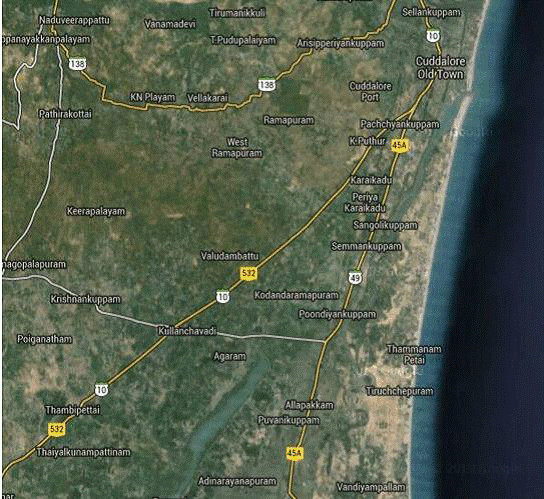 |
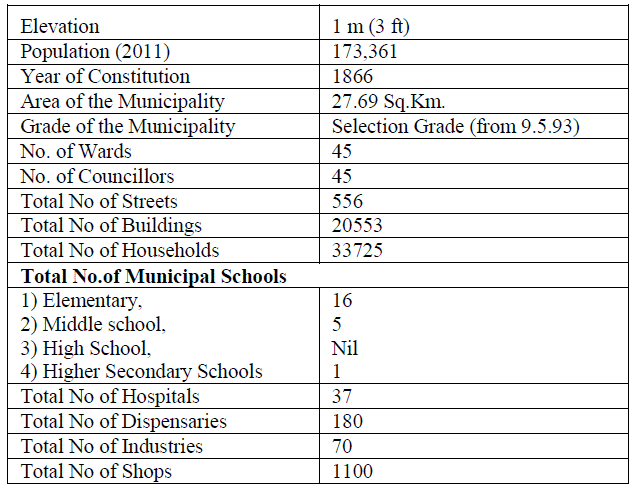 |
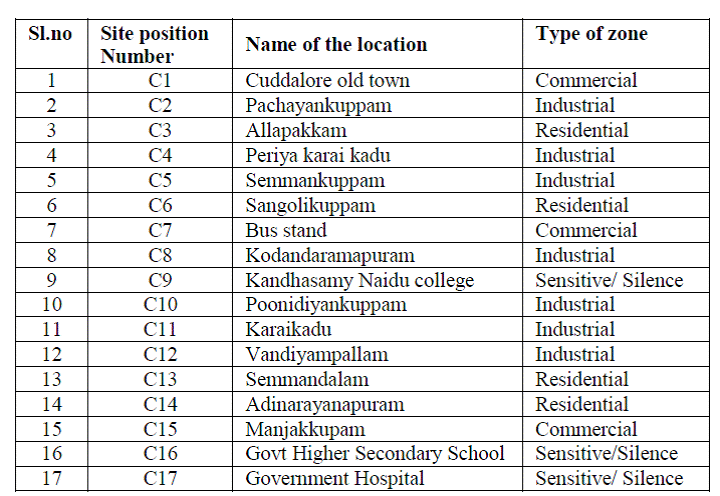 |
PREVIOUS WORK |
| Noise can be emitted from various sources such as aircraft, construction, factories, railway and road traffic. Among those sources, research reported that road traffic is by far the major source of noise in the urban areas contributing to 55% of the total noise (Banerjee et al., 2008; Nirjar et al., 2003). Social surveys conducted in various cities throughout the world have revealed that road traffic noise is the major source of nuisance and annoyance (USDOT, 1995; Dora, 1999). In an urban noise study conducted by Calixto et al. (2003), about 73% of the respondents believed that road traffic noise was the main source of annoyance. In the European Union, about 40% of the people are exposed to road traffic noise exceeding 55 dB (A) during daytime and more than 30% during nighttime (The national Board of Health and Welfare, 2001). Noise effects depend on various factors such as time duration, noise source level, distance from the source and age subgroups. Vulnerable people such as elderly and young children are severely more affected by noise pollution. For instance, several studies have shown that noise intrusion can result in decreasing children's learning skills, productivity and performance (Mato and Mufuruki, 1999). |
| The health impact associated with the noise pollution on human well being is well documented in literature (Briggs et al., 2008; Belojevic et al., 2008;Clark et al., 2006; Hyder et al., 2006; Lam et al2008; Piccolo et al., 2005) . The most obvious impact of noise is damage to hearing ability ranging from slight impairment to nearly total deafness depending on intensity and duration of noise (Davis and Masten, 2004; Morillas et al., 2002). Noise exposure can also cause non-auditory effects that can be categorized into short- and long-term effects. Short term, but serious, impacts include interference with speech communication, disturbance of rest and sleep, annoyance, interference with intended activities as well as general diminution of quality of life (Ouis, 2001; Morrell et al., 1997). Nagi et al. (1993) found that the noise level produced by household equipment and appliances sometimes reaches up to 97 dB which is more than double the acceptable (45dB) noise level. This excessive noise could carry several ill-effects viz. annoyance, speech interference, sleep disturbance, mental stress, headache, and lack of concentration. Similarly Singh (1984) noted that the workers exposed to high noise levels have a higher incidence of circulatory problems, cardiac diseases, hypertension, peptic ulcers, and neurosensory and motor impairment. The adverse effects of noise have not even spared the birds (Robins, sparrows, wrens and blackbirds). Those living near busy roads could not hear each other and thus unable to contact for propagation (Deutche Presse-Agentur, 2003). |
| The effects of noise has been studied on humans (Lipfert et al., 2006; Belojevic et al., 2008; Briggs et al., 2008; Zaheeruddin and Jain, 2008; Fyhri and Klaeboe, 2009; Jakovljevic et al., 2009), animals (Jaeger et al., 2008; Moura et al., 2008; Zhang et al., 2008), plants (Watts et al.,, 1999) and buildings (Akdag, 2004; Naticchia and Carbonari, 2007). Noise is a major factor that should be considered in the design and construction of new transport systems, as well as when improvements are made to existing systems (Abo-Qudais and Alhiary, 2007). In addition, local authorities and environmentalists recognize the importance of monitoring trends in noise pollution when developing mitigating plans. As such, there is an obvious need to measure and model noise pollution. Due to cost and time restrictions, the modeling of noise is often preferred to its measurement over regional areas (Gundogdua et al., 2005) and such modeling takes into account various traffic parameters. Abo-Qudais and Alhiary (2007) modeled noise levels at signalized intersections using parameters including traffic volume, speed, British Pendulum Number (BPN - a measure of surface roughness), heavy vehicle number, slope (%), number of a street lanes, and lane width (m). |
MATERIALS AND METHODS |
| Noise measurements were carried out by using Sound Level Meter YF- 20. Noise levels were measured at 17 stations, Cuddalore old town, Pachayankuppam, Allapakkam, Periya karai kadu, Semmankuppam, Sangolikuppam, Bus stand, Kodandaramapuram, Kandhasamy Naidu college, Poonidiyankuppam, Karaikadu, Vandiyampallam, Semmandalam, Adinarayanapuram , Manjakkupam , Government Higher Secondary School and Government Hospital. Kandhasamy Naidu College, Govt Higher Secondary School and Government Hospital represented the silence zone. Pachayankuppam, Periya karai kadu, Semmankuppam, Sangolikuppam, Kodandaramapuram Poonidiyankuppam and Karaikadu represented the industrial zones. Allapakkam, Sangolikuppam, Semmankuppam and Adinarayanapuram represented the residential zone. Cuddalore old town, Bus stand and Manjakkupam represented the commercial zone At each sampling site six readings were taken after an interval of every 45 minutes. Average, maximum and minimum values were calculated and compared with standards prescribed by the Central Pollution Control Board. A crosssectional study has been conducted involving 100 randomly selected persons. The age of workers ranges from 20 yr to 55 yr. A comprehensive questionnaire was formulated to assess the subjective information. The questionnaire included age, noise exposure, working hours, use of protective measures, noise annoyance and awareness. The questionnaire was The sound level meter was provided with a windscreen to minimize the influence of wind during measurements. |
| A vehicle count was recorded based on various classifications of vehicles. Measurements were performed in one month from 1st to 30th days in June 2012.Before taking the measurements, the sound level meter was suitably calibrated according to level meter producer instructions. The sound level meter was placed on the pavement of the street at a height of about 1.2 m and at a distance of about 7.5 m from the existing road level. Table 3 shows that the Ambient noise standards prescribed by CPCB, New Delhi, India. |
 |
| Assessment of noise level or sound pressure level in dB(A) (A- weighted decibels) was carried out using Sound Level Meter (SLM) in different zones of the study area including three commercial locations, four residential locations, two educational institutions, one hospitals and seven industrial locations. The sound level meter used, can measure the sound frequency from 300 Hz to 8 kHz and from 40 dB to 130 dB in A-weighted scale at four ranges. i.e. 40 to 70 dB (A) for low; 60 to 90 dB (A) for medium; 80 to 110 dB (A) for slightly high and100 to 130 dB (A) for higher intensity of sound. The noise level were measured at different locations of the Cuddalore town covering different zones viz. commercial, residential ,silence zones (educational institutions and hospitals) and residential zones for one month. Atmospheric data such as air temperature, humidity and surface temperature were measured at the time of measurement. The air temperature in °C and humidity in %. |
RESULTS AND DISCUSSIONS |
| The study area is subjected to problems encountered due to pressure of rapidly increasing and unplanned traffic volume. The roads in the study area have been observed to be over flown with voluminous traffic throughout the day. The results of observation and field data are analyzed and discussed in this section. Through questionnaire, the attitudinal response of individuals has been collected and it is clear that they are facing some major problems like headache, less concentration, fatigue, stress, and tiredness during the time period 8 AM-8 PM |
| A. Silence zone |
| Table 4 shows that the average noise level at Kandhasamy Naidu College ranged between 67.50 and 72.16 dB (A).Table 5 indicates that the noise level at Government Higher Secondary School recorded between 65 and 71 dB (A).The average noise level at Government Hospital recorded between 68 and 71.33 dB (A) as shown in table 6. Noise levels recorded in all the sites of silence zone exceeded the prescribed standard level of 50 dB (A). All the places selected under silence zone had noise level above the permissible limit set by CPCB. These high noise levels will cause adverse health effects and aggravate the problems of the patients. The students in the educational institutes will get distracted and lose their concentration and interfere with the studies of student community in the campus. The high traffic flow is the major cause of high noise level. Fig. 2 shows the Noise Level in some Hospitals & educational institute (Silence zone) of Cuddalore town. |
 |
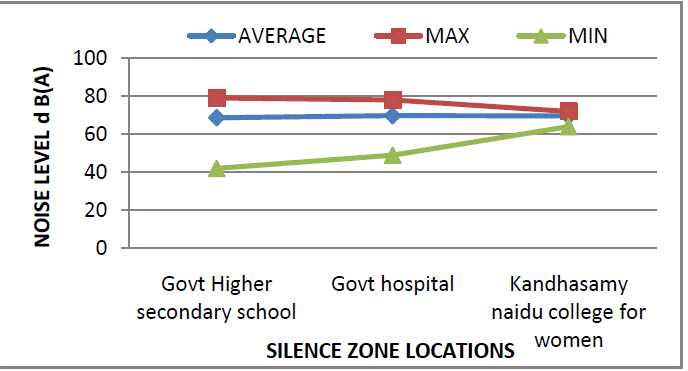 |
| B . Commercial zone |
| Table 7 shows that the average noise level at Cuddalore old town ranged between 70.66 and 74.66 dB (A).Table 8 indicates that the noise level at Bus stand recorded between 88.83 and 92 dB (A).Table 9 shows that the average noise level at Manjakkupam Road recorded between 66.16 and 73.66 dB (A). Fig. 3 shows the noise Level in old town Bus stand and Manjakkupam (Commercial zone) of Cuddalore town |
 |
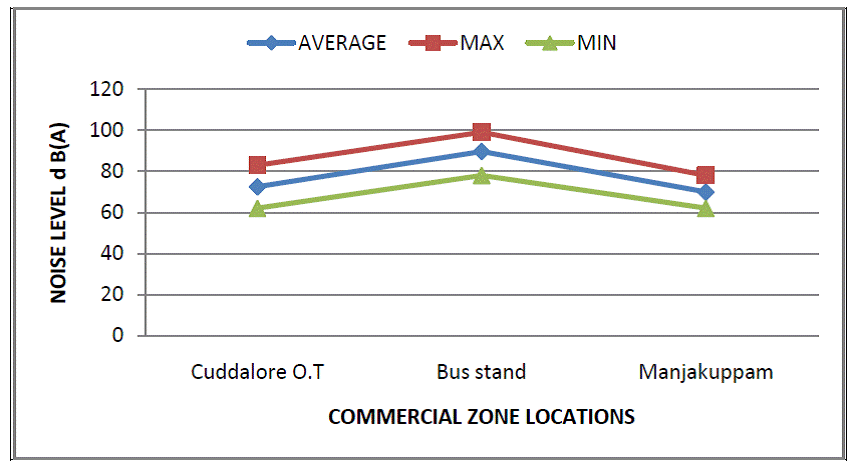 |
| C. Residential zone |
| Table 10 shows that the average noise level at Allapakkam ranged between 67.82 and 73.28 dB (A).Table 11 indicates that the noise level at Sangolikuppam recorded between 68.33 and 72.23 dB (A). Table 12 indicates that the noise level Semmandalam recorded between 68.33 and 72.23 dB (A).Table 13 shows that the average noise level at Adinarayanapuram recorded between 67.66 and 72.66 dB (A). Fig. 4 shows the noise Level in Allapakkam, Sangolikuppam, Semmandalam and Adinarayanapuram (Residential zone) of Cuddalore town |
 |
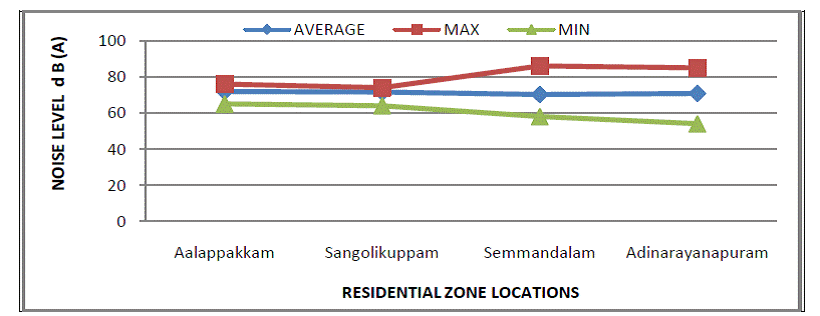 |
| D. Industrial zone |
| The average noise level ranging between 70.50 and 73.83 dB (A) at Pachayankuppam and 67.83 and 72.66 dB (A) at Periya karai kadu are shown in Tables 14 and 15 respectively. Table 16 shows that the average noise level at Semmankuppam ranged between 67.82 and 73.28 dB (A).Table 17 indicates that the noise level at Kodandaramapuram recorded between 68.33 and 72.23 dB (A). Table 18 indicates that the noise level Poonidiyankuppam recorded between 68.33 and 72.23 dB (A).Table 19 shows that the average noise level at Karaikadu recorded between 67.66 and 72.66 dB (A). Table 20 shows that the average noise level at Vandiyampallam recorded between 67.66 and 72.66 dB (A) Fig. 5 shows the noise Level in Pachayankuppam, Periya karai kadu, Semmankuppam, Kodandaramapuram, Poonidiyankuppam , Karaikadu and Vandiyampallam (Industrial zone) of Cuddalore town. Use of horns and traffic congestion is the main cause of noise pollution in these areas. High noise levels and annoyance values were due to overpopulated road ways with bad conditions, broken roads, minimal traffic management, and frequent misuse of horns at all the selected sites. Improper stoppage of public transportation facilities also increases the congestion level. |
 |
 |
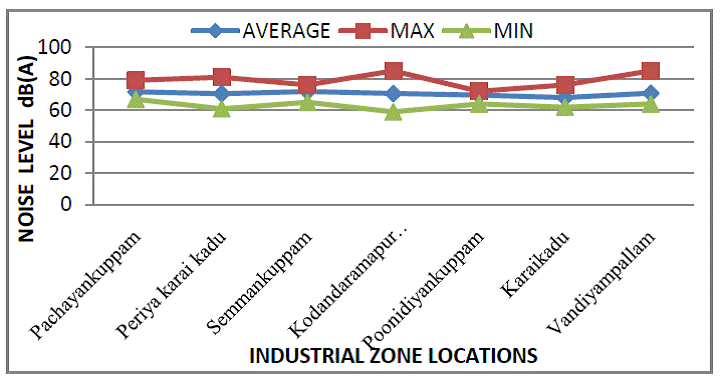 |
| E. Effects of Noise |
| There is no doubt that the noise affects human health adversely. The noise may result in loss of hearing, stress, highblood pressure, loss of sleep, distraction affecting productivity, and a general reduction in the quality of life. The effects of noise are difficult to quantify because tolerance levels among different populace and types of noise vary considerably. There is a large amount of scientific literature assessing the effects of noise on human beings. Indiscriminate use of horn by the vehicles and wide spread use of loudspeakers in Indian social and religious ceremonies caused several health hazards to the urban inhabitants. It may cause deafness, nervous breakdown, mental disorder, heart troubles, high blood pressure, dizziness and insomnia (Bhargawa, 2001). |
| Exposure to noise pollution exceeding 75 decibels for more than eight hours daily for a long period of time can cause loss of hearing. The hazards increase with the intensity of the noise and the period of exposure. The sound produced by a bursting cracker, exceeding 150dB, can cause a ringing sensation called 'tinnitus' and can impair hearing permanently. In general about 1 percent of the population suffers from noise-induced pollution. |
CONCLUSION |
| The noise assessment of the Cuddalore town indicated that the noise levels in the town are escalating at a very fast rate with growing population and heavy traffic accumulation. Noise levels obtained at different locations of the town viz. commercial, residential, industrial and silence zones are found to be exceeding the noise level /limits prescribed by the CPCB and "The Noise Pollution (Regulation and Control) Rules, 2000". It was also observed that in many commercial areas of the town, the noise level exceeded 62-99 dB (A) whereas in residential areas highest noise level recorded between 58-86 dB (A). In silence zones noise levels exceeded 42-86 dB (A). In industrial zones noise levels exceeded 59-85 dB (A) It was also observed that higher noise level in the town is due to rapid and unplanned urbanization resulting in great influx of people from all parts of the region and country, improper management of town roads and traffics, lack of sufficient parking spaces and exponential growth of both private and public vehicles in the city. This research study is based on the expected relationship between traffic noise and its effect on human work efficiency in his/her respective working places. From the survey and findings it is evident that road traffic noise affects human work efficiency at Government Offices, Private Organizations, and Commercial Business Centers beside the busy main roads. Noise is undesirable or unwanted sound. Extended exposure to excessive sound has been proved to produce physical and psychological damage. Because of its annoyance and disturbance implications, noise adds to mental stress and hence affects the general well being of those exposed to it. Noise is a major source of friction among individuals. The results of this study show that the level of noise pollution in Cuddalore town far exceeds the acceptable limits set by the CPCB. Even in the residential areas and vulnerable institutions like schools and hospitals, noise level is much higher than the acceptable limit. This has serious implication on the general health and well-being of the inhabitants of the city. It is also observed .that noise level is closely related with the number of motor vehicles. Urgent measures should be taken to control the level of noise pollution in the town. To reduce noise pollution, several measures can be implemented which include proper maintenance of vehicle and roadway, plantation of trees and construction of sound barriers. Noise pollution is becoming a major public health concern with all of its potential biological and social effects on the body such as cardiovascular, hearing, performance at school and at work, and psychological. This is an especially concerning area for children who are experiencing hearing loss at younger ages that may ultimately affect their learning. These children may be at risk for performing poorly in school and in turn will affect their future career potential. The cardiovascular effects on children may also lead to chronic illness in adulthood. |
References |
|